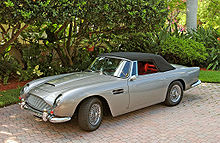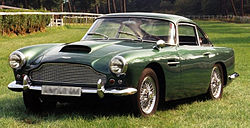Aston Martin DB5
 | |
| Manufacturer | Aston Martin |
|---|---|
| Production | 1963–1965 1,023 produced |
| Predecessor | Aston Martin DB4 |
| Successor | Aston Martin DB6 |
| Class | Grand tourer |
| Body style | 2-door 2+2 coupé 2-door convertible (123) 2-door shooting brake (13) |
| Layout | FR layout |
| Engine | 3995 cc Tadek Marek I6 |
| Transmission | ZF 5-speed all-synchromesh manual or Borg Warner DG automatic (changed to Borg-Warner Model 8 shortly before the DB6 replaced the DB5) |
| Length | 4.57 metres (179.9 in) |
| Width | 1.68 metres (66.1 in) |
The Aston Martin DB5 is a luxury grand tourer that was made by Aston Martin. Released in 1963, it was an evolution of the final series of DB4. The DB series was named honouring David Brown (the head of Aston Martin from 1947–1972). The DB5 is famous for being the first and most recognised cinematic
James Bond car, first appearing in Goldfinger.
James Bond car, first appearing in Goldfinger.
Design
The principal differences between the DB4 and DB5 are:
- The all-aluminium engine was enlarged from 3.7 L to 4.0 L,
- A new robust ZF five-speed transmission
- Three SU carburettors
Producing 282 bhp (210 kW), which propelled the car to 145 mph (233 km/h), this engine, available on the Vantage (high powered) version of the DB4 since March 1962, became the standard Aston Martin power unit with the launch in September 1963 of the DB5.
Standard equipment on the DB5 included reclining seats, wool pile carpets, electric windows, twin fuel tanks, chrome wire wheels, oil cooler, magnesium-alloy body built to superleggera patent technique, full leather trim in the cabin and even a fire extinguisher. All models had 4 seats and 2 doors.
Specifications
Standard coupe:
- Engine: 3,995 cc (243.8 cu in) Inline-6
- Power: 282 bhp (210 kW) at 5500 rpm
- Torque: 288 lb·ft (390 N·m) at 3850 rpm
- Weight: 1,502 kg (3,310 lb)
- Top Speed: 145 mph (233 km/h)
- 0–60 mph (97 km/h) Acceleration: 7.1 s
Performance data from Motor magazine road test, 6 February 1965.
Variants
DB5 Vantage
The high-performance DB5 Vantage was introduced in 1964 featuring three Weber twin-choke 45DCOE side-draft carburettors and revised camshaft profiles, delivering greater top-end performance at the expense of overall flexibility, especially as legendary Webers are renowned as 'full-throttle' devices. This engine produced 315 hp (235 kW). Only 65 DB5 Vantage coupés were built.
DB5 convertible
Just 123 convertible DB5s were produced, though they never used the typical "Volante" name. The convertible model was offered from 1963 through to 1965. Originally only 19 of the 123 DB5 Convertibles made were left-hand drive. 12 cars were originally fitted with a factory Vantage engine, and at least one further convertible was subsequently factory fitted with a DB6 specification Vantage engine.
From October 1965 to October 1966, Aston Martin used the last 37 of the Aston Martin DB5 chassis' to make another convertible model. These 37 cars were known as "Short Chassis" Volantes and were the first Aston Martins to hold the "Volante" name. Although calling it a "Short Chassis" is a bit of a misnomer as the "short" comes from comparing it to the subsequent DB6, which has a longer chassis. When compared to the DB5, it is not "short" but rather the same size, however these cars differ to the DB5 convertible models as they feature DB6 split front and rear bumpers and rear TR4 lights, as also used on the DB6.
DB5 shooting brake
A prototype DB5 shooting brake was custom produced by the factory for David Brown, an avid hunter and dog owner, and 11-12 more coupés were custom modified for Aston Martin by independent coachbuilder, Harold Radford. The taillights used were Triumph units, and were also adopted for the succeeding DB6.
James Bond's DB5
The Aston Martin DB5 is one of the most famous cars in the world thanks to Oscar-winning special effects expert (also known as 'the Real Q') John Stears, who created the deadly silver-birch DB5 for use by James Bond in Goldfinger (1964). Although Ian Fleming had placed Bond in a DB Mark III in the novel, the DB5 was the company's latest model when the film was being made.
The car used in the film was the original DB5 prototype, with another standard car used for stunts. To promote the film, the two DB5's were showcased at the 1964 New York World's Fair, and it was dubbed "the most famous car in the world", and subsequently sales of the car rose. In January 2006, one of these was auctioned in Arizona; the same car was originally bought in 1970 from the owner, Sir Anthony Bamford, by a Tennessee museum owner. A car, mainly used for promoting the movie, is now located in the in the Louwman Museum, Netherlands.The first DB5 prototype used in Goldfinger with the chassis number DP/216/1 was later stripped of its weaponry and gadgetry by Aston Martin and then resold. It was then retrofitted by subsequent owners with nonoriginal weaponry. The Chassis DP/216/1 DB5 was stolen in 1997 from its last owner in Florida and is currently still missing.
Within the universe of James Bond, the same car (registration BMT 216A) was used again in the following film, Thunderball, a year later. A different Aston Martin DB5 (registration BMT 214A) was used in the 1995 Bond film, GoldenEye, in which three different DB5s were used for filming. The BMT 214A also returned in Tomorrow Never Dies (1997) and was set to make a cameo appearance in the Scotland-set scenes in The World Is Not Enough (1999), but these were cut in the final edit. Yet another DB5 appeared in Casino Royale(2006), this one with Bahamian number plates and left-hand drive (where the previous British versions had been right-hand drive). Another silver-birch DB5 with the original registration BMT 216A will appear in the 23rd James Bond film, Skyfall (2012).
On 1 June 2010, RM Auctions announced the upcoming auction of a DB5 used in both Goldfinger and Thunderball. The owner (Jerry Lee, President/Owner of WBEB Radio in Philadelphia, PA) originally bought the car from the Aston Martin company in 1969. At the auction, the DB5 was sold for 2,600,000 GBP.
Promotional items
With Goldfinger, Corgi Toys began its decades-long relationship with the Bond franchise. Producing a toy of the car, which became the biggest selling toy of 1964. A highly detailed kit was also produced by Airfix between 1966 and 1970.
A highly detailed 1:24 scale die-cast model with many working features was produced as a limited edition in 2006 for Casino Royale, by the Danbury Mint. In January 2011 a 1/8 scale model was released by part work magazine publisher GE Fabbri in the UK. Over 85 weekly parts, the model builds into one of the biggest 007 scale models to date, with working gadgets and lights.
Use in popular culture
The DB5 is famous for being the first and most recognised cinematic James Bond car. It was also used by actor Roger Moore, as he played a James Bond parody character in the film The Cannonball Run. It appears in several video games such as 007 Racing, James Bond 007: Agent Under Fire, From Russia with Love, and James Bond 007: Blood Stone.
In the 2011, an Aston Martin DB5 appeared in heavily stylized form as 'Finn McMissile', a British secret agent voiced by Michael Caine in the 2011 Pixar film Cars 2. The car character was an homage to the Bond DB5.





















![Validate my RSS feed [Valid RSS]](valid-rss-rogers.png)














































































